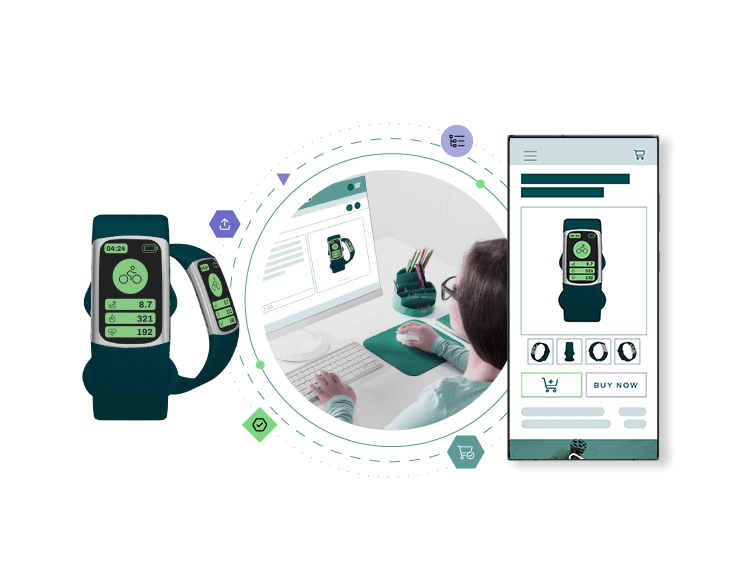Top-performing brands understand the benefits of implementing and executing a direct-to-consumer (DTC) strategy. DTC marketing and sales provide a straightforward path to success.
As with any marketing approach, a profitable DTC strategy requires business owners to understand the ins and outs of the methodology. This article explores why every business should create a DTC strategy and the best practices for implementing it in your business.
Why a DTC Strategy Matters for Your Business
DTC marketing and sales allow brands to bypass traditional distribution channels and sell directly to their customers. In the past, businesses like yours had to rely on third-party sellers and retailers to sell products.
But DTC empowers brands to pave their way –– on their terms –– to engage and convert customers. We list the benefits of DTC marketing below:
- DTC gives you more control over your products, marketing, branding, and distribution.
- You have access to first-party data from customers engaging directly with your business.
- Brands see faster time to market because they don’t need to appeal to retailer demands.
- DTC empowers brands to see better margins. When you don’t need to sell products at a discount, you earn more profits even when selling less volume.
Implementing your DTC strategy can increase revenue and empower you to grow your business without retailer constraints.
While brands with robust DTC strategies reap the rewards of skipping the middleman, building your business requires thoughtful intentionality. If you excel in key areas, you can position yourself to win market share and take hold of the digital shelf.
Best Practices for a DTC Strategy
As outlined above, a successful DTC strategy can benefit your business in myriad ways. It’s not enough –– nor is it wise–– to jump straight into DTC marketing without thoughtful, intentional moves; you must implement best practices to thrive with this marketing and sales method. Read on to learn six best practices for your DTC strategy.
1. Define Your Core Differentiator
What makes you different –– and better –– than your competition? The digital shelf is a continuously expanding retail space. Unlimited access to brands and products means consumers can be selective in the products they choose to buy. Your DTC strategy must include highlighting your core differentiators.
Communicate why the consumer should choose your brand and product over your competition. In essence, define what makes your product worth purchasing. Preemptively address customer questions and concerns and prove why your product is the best solution for their needs or wants.
2. Enhanced Product Imagery
In a digital world, imagery sells your products. When shoppers come to your site or other retail channels, they need quality, informative product imagery. Your product photography allows consumers to closely examine the item in a retail space where hands-on examination isn’t an option.
But product photography shouldn’t stop at a flat 2D image. Enhance product imagery, like 360-degree photography, engages shoppers and delivers the content required for them to make an informed, confident purchase.
High-quality media engages consumers, and it’s often a tipping point in a consumer’s decision-making process. Fifty-six percent of shoppers said high-quality media, like spin imagery, persuaded them to buy a product they didn’t think they needed.
3. Rich Media
Advanced product imagery isn’t the only way to engage with consumers. Rich media allows brands to interact with shoppers, providing an immersive experience that compels purchase.
Rich media like alternate reality (AR) and virtual reality (VR) applications allow consumers to understand your product better. AR and VR product interactions deliver a personalized experience where the shopper can literally see themselves using your product.
Going beyond traditional media empowers you to show consumers why they need your product and why they should buy it now.
4. Showcase Positive Customer Reviews
Reviews are essential to any successful business regardless of your marketing and sales channels. Consumers look to reviews to determine the legitimacy and quality of a brand and its products. Showcasing positive ratings and reviews proves to your shoppers that they can and should purchase your products confidently.
Highlighting your positive reviews is essential when building your DTC strategy. Consider a shopping experience on a retail site like Amazon. Shoppers have access to hundreds, if not thousands, of product reviews.
When consumers come to your site, you don’t have the name recognition of an Amazon or Walmart. But reviews from past and existing customers provide the social proof shoppers demand before making a purchase. Good reviews cultivate trust and confidence, helping you earn that valuable first sale.
5. Include Abundant Product Information on PDPs
Online shoppers need ample product content to make a purchase. 1WorldSync’s Product Content Benchmark report found that seven out of ten online shoppers decide not to buy products due to poor quality or a lack of product content.
An effective DTC strategy includes providing abundant product information on your PDPs, including
- Product specs and dimensions
- Product features
- Instructions for use
- FAQs
- Product images and video, including AR and VR
- Customer reviews
- Shipping details
- Return policies
- Customer service availability
Consumers spend more time interacting with product content than ever. Brands must include more than enough product content to satisfy shoppers trying to find the best product at the best price.
6. Drive Revenue with a PIM System
A DTC model provides many benefits to your business. But, without the right tools, it’s impossible to effectively manage your DTC site, especially as you consider product information and content management.
As noted above, your product content is essential to a successful DTC strategy. Consistent, accurate, engaging content drives traffic and earns sales, so your teams must take a detail-oriented, thorough approach to content management.
Manually managing product content consumes precious time and energy from your teams and increases the likelihood of consistency and accuracy errors. However, implementing a PIM system allows you to manage your product content effectively and efficiently.
PIM solutions enable all team members to work from the same system, increasing their speed and agility. All data is housed within a single source, ensuring all parties work from the same content when editing or adding new pieces.
PIM systems empower your teams to work faster, reduce errors in your product data, allow for real-time updates, and ultimately drive revenue. Exercising complete control over your data through a PIM streamlines the content piece of your DTC strategy, allowing your teams to focus their energy on other crucial aspects of the consumer experience.
Executing Your DTC Strategy with 1WorldSync
Building, implementing, and optimizing your DTC strategy allows consumers to engage directly with your brand. A DTC strategy enhances your online presence to cultivate meaningful interactions that lead to sales.
The success of your DTC strategy relies heavily on the tools and resources you utilize to create and deliver a superior shopping experience. The team at 1WorldSync has the solutions your business needs to thrive in a DTC market. Connect with us today to learn how our tools, systems, and platforms can enhance your DTC strategies.






